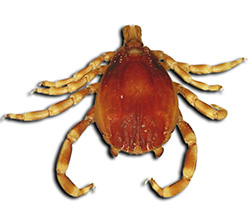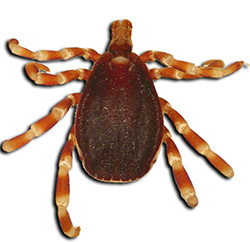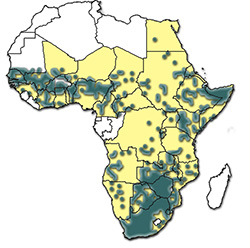Hyalomma spp.
Hyalomma dromedarii | Hyalomma truncatum
Hyalomma dromedarii – the camel tick
This tick transmits Theileria annulata the cause of tropical theileriosis.
The preferred hosts of this tick are camels (Camelus dromedarius), but cattle, sheep, goats and horses may also be infested. The larvae and the nymphs feed on small burrowing animals and on hares, but the nymphs may also infest camels, cattle and horses. Adults attach on the inner thighs, udder, scrotum and in the nostrils of camels.

Hyalomma dromedarii male |

Distribution of Hyalomma dromedarii |
Hyalomma dromedarii is common in the Mediterranean region steppe and desert clilmates, that are north of the equator. Because of its adaptation to camel hosts and extreme dryness, it is found wherever camels occur: in North Africa from Mauretania to Egypt and in North East and East Africa it occurs in Sudan, Erittrea, northern, eastern and southern Ethiopia, northern Kenya and north-eastern Uganda.
Hyalomma dromedarii has a two or a three-host life cycle. The larvae may feed and moult to nymphs on small mammals or hares and the adults feed on large domestic herbivores. The larvae may also feed on small mammal hosts, drop off and moult to nymphs, which can then either attach to other small mammal hosts or feed on the same large animals as the adults. The life cycle appears to be continuous throughout the year.
Hyalomma truncatum – small smooth bont-legged tick
The common name of this tick and that of Hyalomma rufipes is derived from the fact that the distal end of each segment of the legs, which are brown, is encircled by a ivory coloured band, giving the legs a banded appearance. This tick can transmit a toxin causing sweating sickness in cattle and particularly in calves.

Hyalomma truncatum male |

Distribution of Hyalomma truncatum |
With the exception of Lesotho, the eastern Cape Province, the eastern half of the Free State, south-eastern Gauteng and south-eastern Mpumalanga and southern KwaZulu-Natal, H. truncatum is present throughout South Africa. It is present throughout Zimbabwe and much of Mozambique. It occurs in south-eastern and north-western Botswana, central and northern Namibia, and southern Angola. In Tanzania and in Kenya it is present mainly in the south-west, and with the exception of the eastern and western regions it occurs throughout Ethiopia.
Adults feed on cattle, sheep, goats, horses, large wild herbivores, particularly giraffe and eland, and occasionally on dogs. Immature stages of the two African Hyalomma species that belong to the Hyalomma marginatum complex of species, namely Hyalomma glabrum and Hyalomma rufipes feed on scrub hares and ground-frequenting birds (e.g. guineafowls). The immature stages of H. truncatum feed on scrub hares and on gerbilline and murine rodents (e.g. bushveld gerbils (Gerbilliscus leucogaster) and four-striped grass mice (Rhabdomys pumilio)).
Hyalomma rufipes attaches in the hairless area of cattle around the anus and on the genitalia and H. truncatum in the tail switch, around the anus, on the lower perineum and on the legs. They are both found around the hooves of sheep. The immature stages are found on the necks of scrub hares and on the heads and necks of birds.
Both H. truncatum and H. rufipes are two-host ticks. The adults are “hunters” and scuttle along the ground when they detect a host in their vicinity.
Certain strains of H. truncatum contain a toxin in their saliva that causes sweating sickness, an acute dermatitis in cattle, particularly calves. The condition can be reversed when the tick, often attached to the tip of the tail, is removed. When the ticks infest dogs they tend to cluster at one site and can cause severe skin necrosis. The long mouthparts cause tissue damage in cattle and sheep and secondary bacterial infections may lead to abscess formation. Its attachment to the lower legs and feet of lambs can lead to lameness. Injuries caused by the long mouthparts are attractive to the blow fly Chrysomya bezziana. Ticks of the genus Hyalomma can transmit Crimean Congo Haemorrhagic fever virus to human, and H. rufipes is thought to be the chief vector of this virus in southern Africa. Humans can become infected with this virus via tick bites or by crushing infected ticks, or from the blood of infected animals, which exhibit no clinical signs, but are infective for about 14 days after being bitten by an infected tick, or by coming into contact with the blood of infected persons. Hyalomma truncatum and H. rufipes also transmit R. conorii to humans.
Hyalomma truncatum alsotransmits Babesia caballi the cause of equine piroplasmosis. Because the immature stages of H. truncatum do not feed on horses the transmission of B. caballi by this tick has of necessity to take place transovarially.
